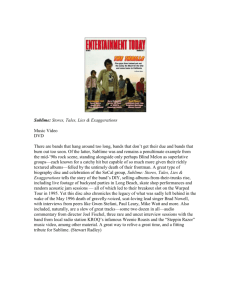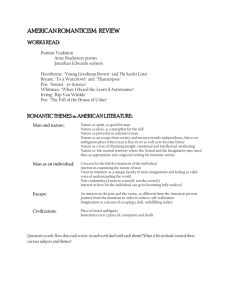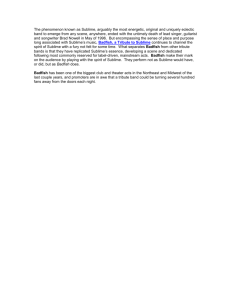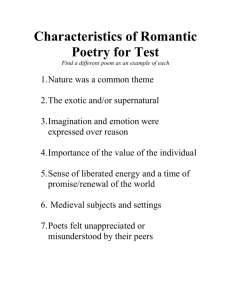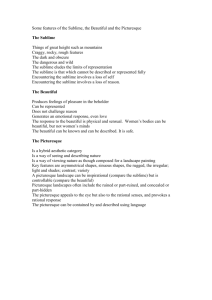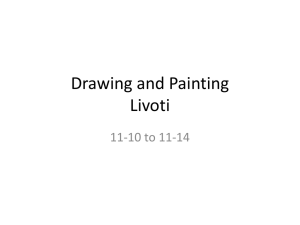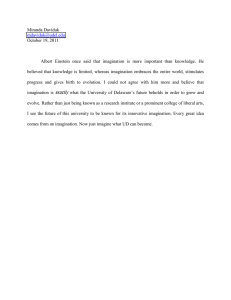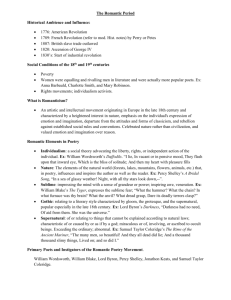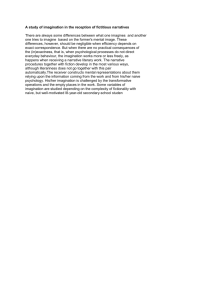EN227, WEEK EIGHT John Clare
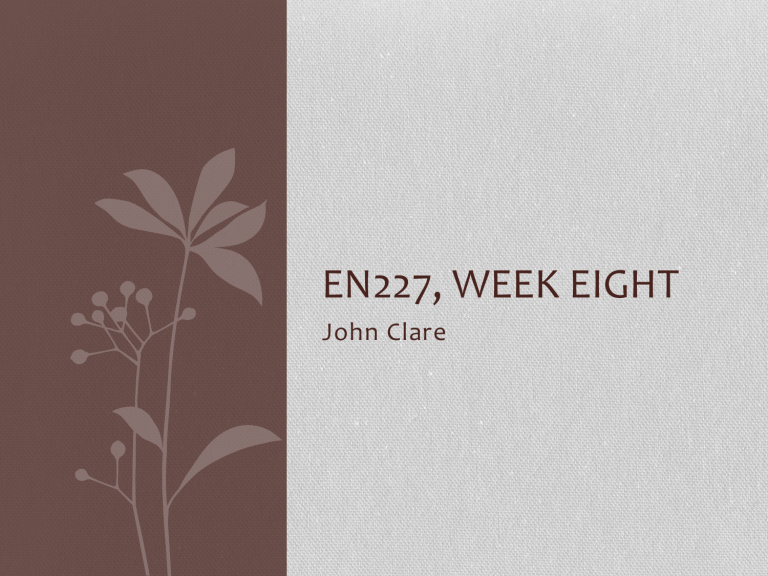
EN227, WEEK EIGHT
John Clare
Close reading paper
• Anything unclear in assign?
• Questions about close reading?
• Questions about poem more generally?
Groupwork
• Each one of you will be assigned to a cluster
• Assignment:
• Describe, comprehensively, how each your assigned concepts appears in each one of these sections
• Then, describe how Clare’s account of this concept is similar, and how it is different—doing so via a close reading of Clare
• Construct a continuum (an axis), and plot each one of these writers on that axis
• Finally: think of one other relevant moment in the poetry we’ve discussed
Romantic aesthetics: Imagination
1. Imagination
In his Letters, Keats replied to Benjamin Bailey’s doubts about the authenticity of imagination by affirming that ‘The Imagination may be compared to Adam’s dream – he awoke and found it truth.’ As described by
Milton in Paradise Lost, Adam’s dream is of Eve, and the truth he discovers is the ‘real’ counterpart to the form he had imagined. This coincidence of human and divine creative powers supports Keats’ view that ‘What the imagination seizes as Beauty must be truth – whether it existed before or not.’ Keats’ view was emblematic of an imagination no longer confined, as was common in earlier thinking, to the representation of ideas and images drawn from experience. It is therefore a productive, rather than reproductive faculty, being a knowledge more profound than that available to reason. Residing at a level too deep to be scrutinised by the conscious mind, the imagination is nevertheless identified as the ultimate source of both nature and the self. The Romantic sense of imagination establishes literature as a privileged index to the imagination and therefore as a source of secular salvation. It was idealised as an organic, individualistic and creative power although some poets scandalously believed these elements could also be found in opium (De Quincey) or were in reality, superficial and fragile (Byron).
http://www2.warwick.ac.uk/fac/arts/english/currentstudents/undergraduate/mod ules/fulllist/second/en227/context/mason
Wordsworth, The Prelude (VI)
Knowledge and increase of enduring joy
From the great Nature that exists in works
Of mighty Poets. Visionary power
Attends the motions of the viewless winds,
Embodied in the mystery of words:
There, darkness makes abode, and all the host
Of shadowy things work endless changes,--there,
As in a mansion like their proper home,
Even forms and substances are circumfused
By that transparent veil with light divine,
And, through the turnings intricate of verse,
Present themselves as objects recognised,
In flashes, and with glory not their own.
Romantic aesthetics: the Sublime
2. Sublime
Discussions of the sublime held a prominent place in literature on aesthetics in this period and was defined in opposition to the beautiful. As Burke argues in his influential A Philosophical Enquiry into the Origin of the our Ideas of the
Sublime and the Beautiful (1757), the sublime is provoked by great and terrible objects, while a sense of the beautiful is aroused by small and pleasing ones.
The first arouses our admiration, the second our love; the one forces, the other flatters, us into compliance, a distinction sharpened by the association of the sublime with men and the beautiful with women. An experience of the sublime characteristically begins with the interposition of an overwhelming force, which shatters equanimity and produces of feeling of blockage. As this power takes hold of mind and emotions, inertia becomes transport: we are hurried on as if ‘by an irresistible force.’ As the experience recedes, it leaves behind a newly invigorated sense of identity and, frequently, admiration for the blocking power. The Romantic sublime has its source in and is revelatory of the individual’s own powers, meaning that great size and grandeur are not always necessary conditions for sublimity. ….
http://www2.warwick.ac.uk/fac/arts/english/currentstudents/undergraduate/mod ules/fulllist/second/en227/context/mason
Barbauld, “Beachy Head”
75 For now the sun is verging to the sea,
76 And as he westward sinks, the floating clouds
77 Suspended, move upon the evening gale,
78 And gathering round his orb, as if to shade
79 The insufferable brightness, they resign
80 Their gauzy whiteness; and more warm'd, assume
81 All hues of purple. There, transparent gold
82 Mingles with ruby tints, and sapphire gleams,
83 And colours, such as Nature through her works
84 Shews only in the ethereal canopy.
85 Thither aspiring Fancy fondly soars,
86 Wandering sublime thro' visionary vales,
87 Where bright pavilions rise, and trophies, fann'd
88 By airs celestial; and adorn'd with wreaths
89 Of flowers that bloom amid elysian bowers.
90 Now bright, and brighter still the colours glow,
91 Till half the lustrous orb within the flood
92 Seems to retire: the flood reflecting still
93 Its splendor, and in mimic glory drest;
Dizzy Ravine! and when I gaze on thee
I seem as in a trance sublime and strange
To muse on my own separate fantasy,
My own, my human mind, which passively
Now renders and receives fast influencings,
Holding an unremitting interchange
With the clear universe of things around;
One legion of wild thoughts, whose wandering wings
Now float above thy darkness, and now rest
Where that or thou art no unbidden guest,
In the still cave of the witch Poesy,
Seeking among the shadows that pass by
Ghosts of all things that are, some shade of thee,
Some phantom, some faint image; till the breast
From which they fled recalls them, thou art there!
Romantic aesthetics: the Picturesque
3. Picturesque
An eighteenth-century theory of landscape which had particular application in the fields of bucolic literature, pastoral poetry and landscape painting. Situated between the historicising landscapes of the seventeenth century and the sublime landscapes of the Romantic period, the picturesque stresses variety in landscape, revealed through an interest in irregularity, ruggedness, rusticity, intricacy and singularity. These qualities (outlined by William Gilpin) were thought to stimulate the imagination, not naturally, but by being reproduced by the artist in a pleasing composition. One technical aid to the discovery of the picturesque was found in the Claude glass, a tinted convex mirror which was designed to render the scene like a picture.
Gilpin argued that it transformed nature into ‘the brilliant landscape of a dream.’ http://www2.warwick.ac.uk/fac/arts/english/currentstudents/undergraduate/mod ules/fulllist/second/en227/context/mason
That very day,
From a bare ridge we also first beheld
Unveiled the summit of Mont Blanc, and grieved
To have a soulless image on the eye
That had usurped upon a living thought
That never more could be. The wondrous Vale
Of Chamouny stretched far below, and soon
With its dumb cataracts and streams of ice,
A motionless array of mighty waves,
Five rivers broad and vast, made rich amends,
And reconciled us to realities;
There small birds warble from the leafy trees,
The eagle soars high in the element,
There doth the reaper bind the yellow sheaf,
The maiden spread the haycock in the sun,
While Winter like a well-tamed lion walks,
Descending from the mountain to make sport
Among the cottages by beds of flowers.
